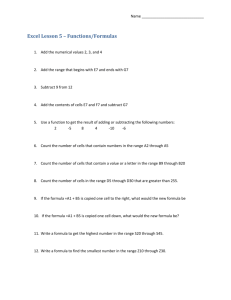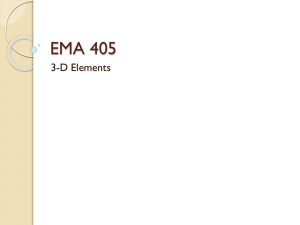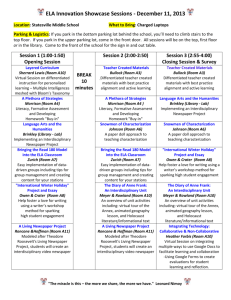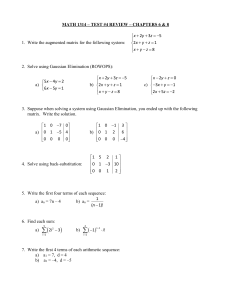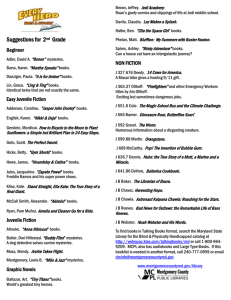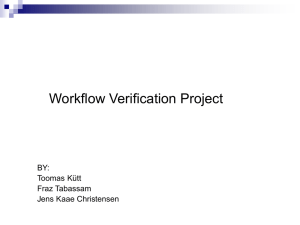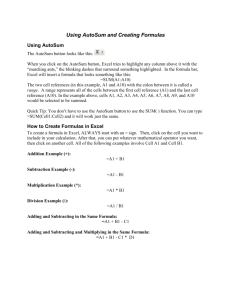Middle Level English Language Arts (ELA)
advertisement
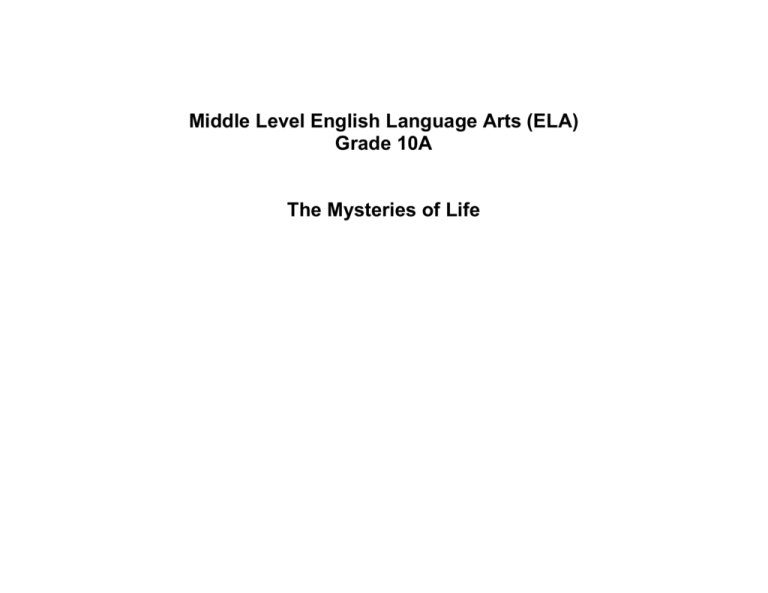
Middle Level English Language Arts (ELA) Grade 10A The Mysteries of Life Unit Overview Context: Multi-genre thematic Timeline: Approximately six - eight weeks (depending on depth of coverage of extended fiction) The Mysteries of Life exposes the students to a variety of literary genre that will help the students recognized that life is full of mysteries from the extraordinary to the common. Our brain has capabilities to imagine beyond our world and our memory helps shapes us as we speculate on the role of destiny in our lives. Humans have always been searching for the answers to life’s mysteries! On our quest for answers, we journey into worlds unknown: worlds within, worlds beyond, and worlds remembered. English Language Arts Goals and Outcomes Overview Comprehend and Respond (CR) CR A10.1 Comprehend and respond to a variety of visual, oral, print, and multimedia texts that address: o o o identity (e.g., Foundational Stories); social responsibility (e.g., Destiny and Challenges of Life); and social action (agency) (e.g., Human Existence). CR A10.2 View, interpret, summarize, and draw conclusions about the ideas and information presented in a variety of illustrations, charts, graphs, and television, film, and video presentations including a documentary or current affairs program. CR A10.3 Listen to, interpret, summarize, and draw conclusions about the ideas and information presented in a variety of literary and informational texts including group discussions, oral readings, interviews, and prepared talks about a topic being studied. CR A10.4 Read, interpret, and draw conclusions about the ideas, information, concepts, and themes presented in a variety of literary (including poems, plays, essays, short stories, novels) and informational (including magazines, newspapers, and on-line information) texts. Compose and Create (CC) CC A10.1 Compose and create a range of visual, multimedia, oral, and written texts that explore: o o o identity (e.g., Foundational Stories); social responsibility (e.g., Destiny and Challenges of Life); and social action (agency) (e.g., Human Existence). CC A10.2 Explain and present to a familiar audience the key ideas and events (actual or based on a text studied) through an appropriate combination of charts, diagrams, sound, models, drama, and print. CC A10.3 Use oral language to express a range of information and ideas in formal (including a prepared talk on a familiar topic, an oral presentation of a passage of prose or poetry, and a retelling of a narrative or a recounting of an experience or event) and informal (discussion and group work) situations. CC A10.4 Compose and create a variety of written literary (including a historical persona essay and a review) and informational (including an observation [eye-witness] report and researched or technical report) texts attending to various elements of discourse (e.g., purpose, speaker, audience, form). Assess and Reflect (AR) AR A10.1 Establish and apply criteria to evaluate own and others’ work. AR A10.2 Set personal language learning goals and select strategies to enhance growth in language learning. Resources Used in This Unit Essays: Visuals: Magazine Articles: 10 Unsolved Mysteries of the Human Brain (Discovery) Songs: Who Am I – Counting Crowns Who Am I – Les Miserables Short Stories: The Tell Tale Heart Night Drive Uneasy Homecoming Radio Play: The Monkey’s Paw Poetry: My Love is Like a Red, Red Rose Sonnet 130 Documentaries: Mystery of the Human Brain Movies: The Tell Tale Heart The Monkey’s Paw Purpose / Outcomes Strategies and Assessment Learning Activities Introduction Introduce the Unit Organizer and discuss the key questions Set purpose to unit Anticipate Message Set Purpose AR10.2 AR A10.2 KWL AR A10.2 Place Mat Questions for Deeper Understanding: How can the human brain reach its potential? How is technology changing the human brain? How do our imaginations carry us beyond the borders of the everyday world? How does imagination positively affect our personal lives, society, and the workplace? Is there a master plan or are we masters of the plan? How do fantasy and science fiction prepare us to handle tomorrow’s challenges? Have students begin to fill in a KWL sheet on the topic of Life’s Mysteries. Use the key questions to guide the ‘Know’ and ‘Wonder’ sections at this point. Complete a Place Mat activity sheet to elicit ideas and deeper thought from all students on the Mysteries of Life. The placemat categories include: Mysteries of the human brain, Mysteries of the world around us, Mysteries of our purpose in life, Mysteries of the future Mysteries of the Human Brain ----- ----Lead a class discussion and brainstorming session. Have the students come up with a top ten list of the unsolved mysteries of the human brain. Have the students record the ideas as a Top Ten List for later reference. Prepare to analyze a documentary by practicing the following skills. Compare/Contrast, Cause/Effect, Levels of Questions, Note-making, Cues and Conventions Note-making Cues and Conventions Teacher information sheet for skill presentation Cornell Note-making FRAME Cues and Conventions FRAME Mysteries of the Human Brain (14 minutes) Discuss the steps in writing of a documentary review. Writing a Documentary Review guide CR A10.2 CC A10.4 Documentary Review Have students write a review for the documentary. CC A10.3 Note-making Discuss the steps in writing a script for a documentary. Have students take notes as you go over the following. How to Write a Script for a Documentary CC A10.2 Video Documentary Have the students work in groups to create mini-documentaries on topics of their choice. The documentaries should be a maximum of 3 minutes in length. Students will need to be very selective in their choice of a topic and be concise and to the point! Scripting will be important to make the documentary interesting and within the time limit. AR A10.1 Assessment Rubric Documentary Assessment Rubric Discovery Magazine article: 10 Unsolved Mysteries of the Human Brain CR A10.4 Compare/Contrast CC A 10.2 Compare the 10 mysteries listed in the article with the Top Ten list created by the class at the beginning of the course. Mini-research project on one of the unsolved mysteries of the human brain. Have each student research and record approximately 10 facts or points on their selected brain mystery. CC A10.2 Compare/Contrast Have students who worked on the same topics compare their findings (compare/contrast) and share the findings with the rest of the class. AR A10.2 Unit Organizer Refer back to the Unit Organizer. Add jot notes to the section that has been completed. What knowledge can be added to the various Key Questions? ----- ----- Mysteries of this World and Beyond CR A10.3 CR A10.4 Theme and Plot Read and listen to the video clip of The Tell Tale Heart by Edgar Allen Poe. The first time have them read and listen to enjoy the story and gain understanding of the theme and plot. Discuss the story with the class The second time through, have the students record descriptive Imagery CR A10.2 Genre Comparison CR A10.4 words and phrases that bring the story to life and make it powerful. Have a discussion following the second time through. Audio clip with words (16 minutes) Now have the students watch the short movie version to see how the director turned these words on a page into a visual genre. Have the students record several of the key scenes and explain how the powerful descriptive phrases were portrayed in the movie. Tell Tale Heart movie (26 minutes) Analysis FRAME Have students read Night Drive by Will F. Jenkins. Review the parts of a short story if necessary. Have them complete the short story analysis handout on the literature. Night Drive by Will F. Jenkins Parts of a Short Story Short Story Analysis CC A10.4 Essay Planner Have students read Uneasy Homecoming by Will F. Jenkins. Review the short story essay outline and have them use the essay planner to develop their essay. Uneasy Homecoming by Will F. Jenkins Short Story Essay Assignment Outline 5 Paragraph Essay planner AR A10.2 Unit Organizer CC A10.4 Refer back to the Unit Organizer. Add jot notes to the section that has been completed. What knowledge can be added to the various Key Questions? ----- ----- Fate and Destiny Who will I become? Who Am I – Les Miserables video clip Song lyrics CR A10.3 Who Am I – Casting Crowns video clip Song lyrics CR A10.4 Concept Comparison FRAME Compare the two songs titled ‘Who Am I’. How are they similar/different? CC A10.4 Paragraph Write a personal paragraph titled “Who Am I.” Why do we love who we do? CR A10.2 AR A10.2 Compare/Contrast Levels of Questioning Cause/Effect Note-making RAFTs The Mysteries of Love Documentary Documentary Teaching Guide Documentary (locate on PBS site) My Love is Like a Red, Red Rose by Robert Burns audio clip Poem Lyrics Sonnet 130 by William Shakespeare CC A10.4 Paragraph Write a paragraph about the Mystery of Love. AR A10.2 Unit Organizer Refer back to the Unit Organizer. Add jot notes to the section that has been completed. What knowledge can be added to the various Key Questions? ----- ----- The Fantastic The Monkey’s Paw by W.W. Jacobs Script Radio Play (myoldradio.com) Short Movie (30 minutes) CR A10.3 CR A10.2 Create own script and dramatic performance. Groups of 1 – 6 students. CC A10.1 A Midsummer’s Nights Dream or Frankenstein could be studied as an option at this point. SparkNotes: Frankenstein SparkNotes: Midsummer … AR A10.2 Unit Organizer Refer back to the Unit Organizer. Add jot notes to the section that has been completed. What knowledge can be added to the various Key Questions? ----- ----Unit Assessment ------------------------------Unit Assessment
